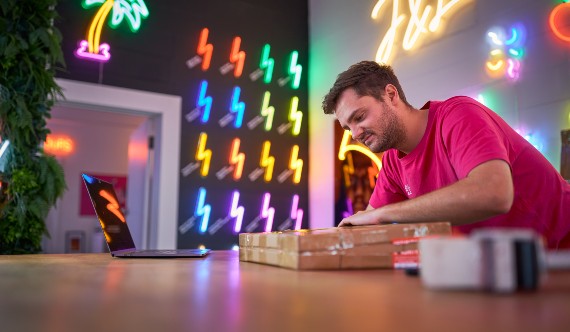Tackling problems with asset tracking
Mainfreight had a problem.
The multinational logistics giant could not tell where its bins were. Specifically, Mainfreight couldn't tell exactly where its chemical waste segregation bins were, or even how many of those bins it had.
"We'd had a problem for a long, long time," says the company CTO Kevin Drinkwater. "These are very useful devices for us for segregating dangerous goods, to make them safe when we transport them. And we had no idea where they were. Well, not where all of them were – we knew where some of them were."
But "some" wasn't good enough. For years Mainfreight explored ways to track its assets. To complicate things, Mainfreight knew that some bins weren't falling off the ledger, but were being deliberately diverted. (It turns out that segregation bins are very handy as fish smokers.)
"We started off with the tried and true manual methodology," says Kevin, "and really that wasn't working, because the more the business grew, the more we had of these things and the more time pressure people had going around the yard and trying to find these things and sending an email. It just wasn't working."
The fix the company found in the end demonstrates a couple of important things about effective IoT solutions: As the lead customer for Spark's new Internet of Things asset tracking product, Mainfreight learned that IoT solutions aren't tech fairy-dust; they tend to address well-established business problems.
Read Mainfreight's IoT story
A simple but effective solution
Mainfreight also learned that the right solution is very often a simple one.
"It was totally a business need," says Kevin. "It was the business that had the pain point. There was certainly no basis for saying, 'Hey, here's a cool tech. We should use this on something. Let's find it.' We knew that we were buying between 50 and 100 of these $3,000 boxes a year.
"We knew that IoT was a solution that would work for us. We actually found some very interesting solutions that could tell us all sorts of things. But the battery wouldn't last. The other problem was that the coverage of the network they were on was just not there either."
What turned out to do the job was Spark's solution, a rugged IoT device called an Oyster. It's attached to each bin and set up so that it calls in with its location once a day over Spark's LoRa network. The network was reliable and, crucially, the tech was easy on the batteries.
"Battery life made it worthwhile for us. These are devices that you don't want to be changing the battery on every three weeks, every three months even. We're hopeful that it'll be three to five years and based on testing that's the case. But that was the critical thing, it was battery life. That was the Achilles heel of all the other solutions we had looked at over the last 10 or more years."
Mainfreight's experience validated not only of Spark's choice of IoT technology, but its decision to target asset tracking as its first IoT product roll-out.
Learn more about Spark IoT Asset Tracking
Asset tracking from Spark NZ
"It's a really common problem," says Spark's Managed Services Lead Michael Stribling. "You'd go and talk to a range of different organisations, whether that's a manufacturer, somebody in transport or logistics, or somebody in agriculture – there's a whole lot of things of value or things that people want to be able to track and just know where they are. So, for me it's a big market, it's a big opportunity. And it's a relatively simple solution. It's a simple device that you can clip onto an item and be able to get an outcome pretty quickly."
Michael says that simplicity is the key.
"IoT can sound complex but in reality, there are three components:
The first is the networks. So, you've got to have a way to be able to connect to the device. The second is a physical device, something that's actually capturing location information, transmitting that back through the network. And then the third is a platform, which to me really means a way to visualise the information that we're tracking or capturing on the sensor and then being able to do something with it. And that's actually where the value lies – being able to do something with that information."
Mainfreight's platform is a dashboard developed by Spark's IoT software partner, the New Zealand company Blackhawk Technology. The dashboard is visible to everyone involved in the operation.
Learn more about the Blackhawk platform
"So they can see it and all the branches," Kevin explains. "They know they don't have to go and look, that they've got 14 of them [the bins] there. They can see on a dashboard that three of them have been sitting somewhere for 72 hours. You know one of them just got there last night. They can see all the parameters. So they know what they have to do. There's no hiding, there's no excuses."
The result for the company has been "a complete culture change" among staff, says Kevin.
"They don't think knowing where their seg bins are is an impossible task or something they don't want to do.
The critical thing for us is that we have this freight imbalance between the North Island and the South Island, principally from Auckland. And we have to get these bins back to Auckland and Hamilton mainly. People see them and they know they have to get them back because they know the guy in Auckland knows that they've got them. So there's no hiding anymore. And it didn't take long for them to find that out. So the culture changed completely."
For Michael and Spark, logistics is only the start for IoT asset tracking.
"I think there's a huge opportunity in asset tracking," Michael says. "We've only scratched the surface on both the use cases where asset tracking works and the types of industries where we could see it applied. Freight and logistics, manufacturing, agriculture, healthcare. There are huge opportunities in each of those markets.
I think asset tracking will be a core part of the IoT story moving forward. And that's why we've chosen to invest in asset tracking as a lead for us."




